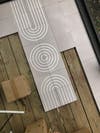Sarah Sherman Samuel’s Breezy New Porch Has the Coolest Floors
Get the look in just four steps.
Updated Oct 12, 2018 11:27 AM
We may earn revenue from the products available on this page and participate in affiliate programs.
Sarah Sherman Samuel knows a good fixer-upper project when she sees one. Case in point: her new home in Grand Rapids, Michigan, where the designer and her family recently moved to from Los Angeles. It was in dire need of a major overhaul, and one area, in particular, needed immediate attention: the screened porch.
“It had a green Astroturf fake rug that basically looked like a putter green carpet from wall to wall,” Samuel explains. “And the walls were all red, so it was very Christmas-themed out there.” Clearly, a makeover was in order, and with warm weather right around the corner—“The summers in the Midwest are beautiful at night,” she says—time was of the essence.
The designer got right to work, painting the walls black to match the new exterior color of the house and filling the space with light and airy seating, woven accents, and more than a dozen plants. “It feels like you’re in a greenhouse, but it’s not stuffy. It just feels natural, like a really cool café, because we have a bistro table out there. We can sit and eat, but then the sofas are crazy comfortable.”
The best feature is underfoot: a clever DIY lavender-gray floor Samuel laid down on top of the decking with tile from her latest collaboration with Concrete Love. Without any grout (to let the rain and snow drain), she installed a pattern using a combination of five tile motifs. Here, she explains how she got it done in just four steps.
Step 1: Prep Your Surface
If you’re applying the tile to an existing deck, first make sure it’s leveled. Power-wash the surface (or scrub it clean if you don’t have a power washer)—any debris or dirt may cause the tile to crack. If you’re creating a brand-new patio, build the platform to the exact measurements of the tile so you won’t need to make any cuts to the edge pieces.
Step 2: Test Out Your Plan
Start at the furthest wall and work toward the door. Do a dry run-through, placing one row and one column of tile without adhesive, to minimize unnecessary cuts and avoid ending up with too small of a sliver of tile when you get to the end.
Step 3: Glue It All Together
Make sure you have a clear idea of your tile pattern. Then apply a generous bead of Liquid Nails construction adhesive to the back of the tile and press it firmly into place. Do this for every tile until you reach the outer edges.
Step 4: Trim Your Edges
Trim the edge tiles to fit with a tile saw (you can rent one at Home Depot if you know your way around power tools). Seal the tile according to manufacturer recommendations. Make yourself a spritz and enjoy the summer sunset.
See more outdoor decor tips: Sarah Sherman Samuel Just Redid Her Backyard—And It’s Full of CB2 Finds 7 Chairs You’ll Actually Want to Bring to the Beach Outdoor Decor So Cool, You’ll Want to Keep It Inside





